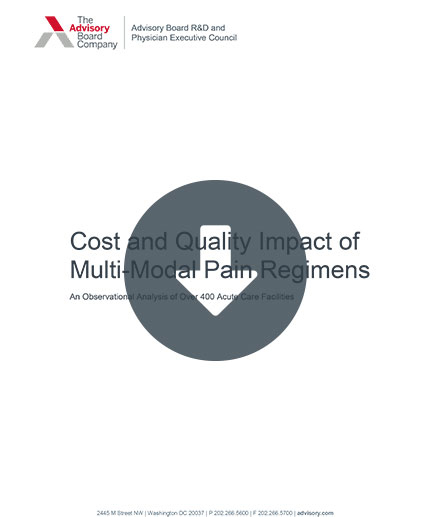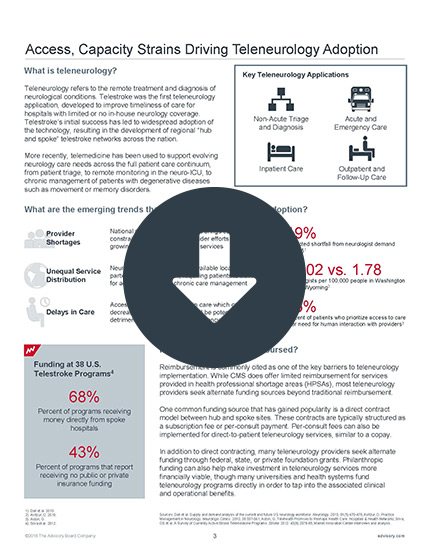Auto logout in seconds.
Continue LogoutRead Advisory Board's take: Three common provider myths about pain management
Chronic pain treatment is an ongoing challenge in the United States, but scientists are working on a variety of ways to improve how pain is measured and managed—without the help of opioids, Laura Landro writes for the Wall Street Journal.
According to Landro, more than 50 million Americans are living with chronic pain. In lieu of proven, long-term solutions for measuring and managing that pain, Landro writes, "doctors have often turned to a blunt, one-size-fits-all treatment: prescription opioids."
But the United States' opioid epidemic and recent research showing opioids are not an effective long-term treatment for pain, has fueled a new wave of research into ways to better measure and manage chronic pain. Landro rounds up five ways researchers are hoping to improve such care.
1. Tapping into the central nervous system to measure pain
For years, doctors have used a 1-to-10 scale or a chart consisting of smiling and frowning faces as ways to measure how much pain a patient is feeling. But now, researchers are looking at how the brain—and greater central nervous system—reacts to pain as a more effective way of measuring it, Landro writes.
For instance, at Stanford University, researchers have developed technology that mirrors the entire central nervous system and can predict how a patient will respond to treatment or whether a patient's chronic pain will improve over time. Mackey said the system eventually could help providers tailor pain treatments to patients. "If we had a way to use brain activity to predict the response to treatment, that is at the heart of precision medicine," Mackey said.
Meanwhile, researchers at Brown University are relying on theta waves to measure pain, Landro writes. According to Landro, one study in animals suggested theta waves, which can be measured using electrodes attached to the scalp, was an effective way to test for pain, as well as evaluate the effectiveness of pain medication.
Carl Saab, director of the center for pain and neural circuits at Brown and Rhode Island Hospital, said the human pain is more complicated than pain in animals, but by combining theta wave measurements with other information, artificial intelligence could develop algorithms to measure and identify different types of pain.
Using these algorithms could "help patients convey their pain level with more accuracy and assist the doctor in reaching an objective pain diagnosis," Saab said. He added, "This is not going to trump or deny what the patient says, it is simply going to bring in this third perspective that is objective, which would be particularly useful if a verbal report cannot be obtained from the patient."
2. Developing a better understanding of how pain affects patients' lives
Other researchers have begun examining how pain impacts a patient's psychological and physical conditions, Landro writes.
For example, researchers at the University of Washington Center for Pain Relief have developed an online pain assessment tool called the PainTracker, which asks patients a series of questions to determine how pain is affecting their lives. After evaluating data from more than 4,000 patients, the researchers found that a large number of patients were experiencing depression, anxiety, and post-traumatic stress disorder, and were severely disabled. The data also showed that many of the patients had a moderate- to high-risk of misusing opioids, Landro writes.
Mark Sullivan, a professor of psychiatry and behavioral sciences who is working on the project, said data from the PainTracker could help doctors evaluate how a patient is experiencing pain and guide them to more effective treatments. "Many patients with chronic pain get hunkered down into this chronic crisis mode where they are just thinking about surviving into the next day," Sullivan said.
3. Utilizing genetics for pain management
Other researchers are turning to genetics to better understand and treat pain.
For example, University of North Carolina (UNC) researchers discovered patients with a certain risk variant in their blood had a more difficult time regulating the stress hormone cortisol after a motor vehicle trauma, and therefore were more likely to experience chronic pain than those without the risk variant.
According to Sarah Linnstaedt, an assistant professor of anesthesiology at UNC's Institute for Trauma Recovery, "The finding helps us understand why some people develop chronic pain after trauma and others do not, and also helped us identify a possible novel target for drug discovery."
Other researchers, like Daniela Salvemini at St. Louis University, are looking into how they can manipulate the body's pain pathways at the molecular level. According to Landro, Salvemini discovered that pain pathways are dependent on two specific molecules, and is now researching whether those molecules could serve as biomarkers for pain associated with a variety of health conditions.
4. Using neurostimulation to treat pain
Neuromodulation, which relies on some form of stimulation to interrupt pain signals, is another field seeing new advances, Landro writes.
For example, Boston Scientific has developed a new spinal-cord stimulator that is implanted into a patient and sends electrical pulses to the brain to treat pain. Maulik Nanavaty, president of the neuromodulation division at Boston Scientific, said the device will allow doctors to provide pain therapy that is most comfortable to individual patients.
However, implants like these come with the same risks as other surgeries, Landro writes, and they can cost as much as $25,000 or more—though they're often covered by insurance.
To that end, researchers are testing less invasive forms of neurostimulation, Landro writes.
For example, at the Carolina Center for Neurostimulation scientists researchers found a treatment called transcranial alternating-current stimulation could enhance naturally occurring rhythms called alpha oscillations and decrease symptoms associated with lower back pain. The treatment uses electrodes placed on a patient's scalp to deliver alternating electrical currents that are so weak patients cannot feel them.
5. Re-examining holistic approaches to pain management
Some experts are looking toward traditional holistic approaches to help manage pain, Landro writes. According to NIH, research suggests that holistic approaches like acupuncture, hypnosis, meditation, spinal manipulation, and yoga could help manage chronic pain. Research also has shown that cognitive behavioral therapy can be a cost-effective way to manage pain, Landro writes.
In an effort to reduce opioid usage for pain management, NIH has doubled its budget for pain and addiction research, according to Landro. Linda Porter, director of the Office for Pain Policy at NIH's National Institute for Neurological Disorders and Stroke, said, "There are appropriate uses for opioids for pain management, but the risks when they are used over the longer term have to be balanced with the benefits. We need to offer people with chronic pain something else, because they are desperate to get better and get back to their lives" (Landro, Wall Street Journal, 2/6).
Advisory Board's take
As this article shows, the pain treatment landscape is changing rapidly. Pain is a tricky issue for providers—it's incredibly widespread, but also highly subjective (making it hard to measure empirically) and difficult to treat (especially as pharmacological solutions become increasingly undesirable in light of the opioid epidemic). Not to mention, treating chronic pain is often expensive for providers, while reimbursement tends to be minimal.
As a result, many providers have shied away from making pain management a strategic priority. Yet as the continuing opioid epidemic makes offering alternative pain management options essential, providers no longer have this luxury. Rather, providers must confront and re-evaluate historical misperceptions about pain management to understand a new reality. Here are three of the most common misperceptions—and why you should overcome them:
- "Outpatient pain management is outside of the hospital's scope." While some providers may see treating chronic pain as outside the scope of traditional hospital service lines, payer pressures are challenging this assumption. Payers are increasingly encouraging programs to exhaust conservative treatment options before approving advanced (often-surgical) treatments. For example, payers typically won't reimburse spine surgery until the patient tries physical therapy and other conservative approaches. Therefore, providers must have these alternative options built into their programs or they risk losing patients when they go to a competitor for lower-acuity care—and then don't return.
- "Low-acuity pain offerings aren't as important as advanced specialty services." While the "bread and butter" low-acuity services aren't the most flashy, unclear care pathways for these services often means that these cases end up being handled by highly specialized providers like surgeons. Creating dedicated pain management programs can help better triage these patients, creating a clear pathway for them first to be seen by advanced practitioners, nurses, physical therapists, or psychologists who can effectively provide this lower-acuity care.
- "Pain services can drain financial resources without a clear benefit." While pain services often aren't profitable in their own right, they can drive substantial downstream revenue. For instance, they can build system loyalty with potential surgical patients, generate referrals, and strengthen program reputation. In addition, programs can advertise their ability to cover the entire pain management care continuum to referrers and patients in order to differentiate themselves in competitive markets.
Whether a greater focus on pain management is achieved through a dedicated service line or a specialty outpatient clinic, best practice programs make this care interdisciplinary. Programs should consider offering medical treatments, physical therapy, behavioral health, and rehabilitation services—an interdisciplinary approach that has been shown to reduce pain and emotional distress.
Don't miss out on the latest Advisory Board insights
Create your free account to access 1 resource, including the latest research and webinars.
Want access without creating an account?
You have 1 free members-only resource remaining this month.
1 free members-only resources remaining
1 free members-only resources remaining
You've reached your limit of free insights
Become a member to access all of Advisory Board's resources, events, and experts
Never miss out on the latest innovative health care content tailored to you.
Benefits include:
You've reached your limit of free insights
Become a member to access all of Advisory Board's resources, events, and experts
Never miss out on the latest innovative health care content tailored to you.
Benefits include:
This content is available through your Curated Research partnership with Advisory Board. Click on ‘view this resource’ to read the full piece
Email ask@advisory.com to learn more
Click on ‘Become a Member’ to learn about the benefits of a Full-Access partnership with Advisory Board
Never miss out on the latest innovative health care content tailored to you.
Benefits Include:
This is for members only. Learn more.
Click on ‘Become a Member’ to learn about the benefits of a Full-Access partnership with Advisory Board
Never miss out on the latest innovative health care content tailored to you.


